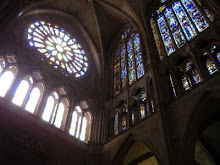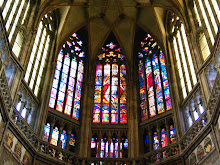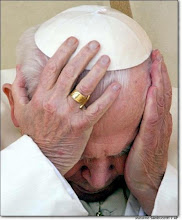29 December 2014
Francis:
"Never condemn. If you feel like condemning, condemn yourself, there's got to be something there, huh?" - During mass on December 15, 2014
12 December 2014
For now, stay
The season of Advent means there is something on the horizon the likes
of which we have never seen before. It is not possible to keep it from
coming, because it will. That's just how Advent works. What is possible
is to not see it, to miss it, to turn just as it brushes past you. And
you begin to grasp what it was you missed, like Moses in the cleft of
the rock, watching God's hindquarters fade in the distance.
So stay.
Sit.
Linger.
Tarry.
Ponder.
Wait.
Behold.
Wonder.
There will be time enough for running. For rushing. For worrying. For pushing.
For now, stay.
Wait.
Something is on the horizon.
[Night Visions by Jan Richardson]
So stay.
Sit.
Linger.
Tarry.
Ponder.
Wait.
Behold.
Wonder.
There will be time enough for running. For rushing. For worrying. For pushing.
For now, stay.
Wait.
Something is on the horizon.
[Night Visions by Jan Richardson]
01 December 2014
The algebra of Advent
By FR. RON ROLHEISER, omi
A couple of years ago, Robert Waller published a book that became a runaway bestseller and an immensely popular movie. Entitled The Bridges of Madison County, it stirred the romantic imagination in a way that few other stories have in recent times, especially as it was played out in its film version by Clint Eastwood and Meryl Streep.
The story runs this way:
A photographer for National Geographic magazine is sent to photograph a series of old bridges in Madison County. Lost, he stops at a farmhouse to ask for directions. As chance would have it, the man of the house has just left for a cattle show. His wife is home alone and she and the photographer instantly sense a deep connection and fall violently in love.
Karma, soulmates, mysticism, whatever, they experience a rare and powerful affinity. Within hours they are in bed with each other, triggering a love affair that leaves them both sacramentally scarred for the rest of their lives.
The viewer of the movie or reader of this book is asked to believe something truly sublime has taken place, a masterpiece of love has been painted, and a noble thing worth more than life itself has just occurred. But can this be so? Can anyone paint a masterpiece in a couple of hours? Can sex with someone you met just two hours before be sublime?
To answer those questions, I suggest you watch another film which, ironically, was playing in theatres at nearly the same time. It's a version of Jane Austin's Sense and Sensibility and tells the story of a young woman who has to carry painful tension (one that includes the same feelings found in Bridges of Madison County) for a long time.
But unlike the characters in Bridges of Madison County, she doesn't quickly resolve it. Nobody is in bed with each other within a couple of hours. She carries the tension for a long time, years, and then finally when it is resolved there is true sublimity.
Why? Because something can only be sublime if first there has been some sublimation.
In essence, this expresses the meaning of Advent: For something to be sublime there must first be sublimation; fasting is the necessary prelude to feasting; greatness of soul is contingent on first nobly carrying tension; and what's truly divine can only appear after a certain kind of gestation.
Advent is about proper waiting.
It should therefore not be confused with Lent. The crimson-purple of Advent is not the black-purple of Lent. The former symbolizes yearning and longing, the latter repentance. The spirituality of Advent is not about repentance, but about carrying tension without prematurely resolving it so that what's born in us and in our world does not short-circuit love's rhythms.
What is the connection here? How does carrying tension help lead to the sublime? It does it by helping to produce the heat required for generativity.
An image might be helpful here. John of the Cross, in his book, The Living Flame of Love, compares our pre-Advent selves to green logs that have been thrown into a fire, the fire of love. Green logs, as we know, do not immediately burst into flame. Rather, being young and full of moisture, they sizzle for a long time before they reach kindling temperature and can take into themselves the fire that is around them so as to participate in it.
So too the rhythm of love: Only the really mature can truly burst into flame within community. The rest of us are still too self-contained, too green, too damp. We don't burst into flame when love surrounds us. Rather our dampness helps extinguish the communal flame.
What helps change this is precisely the tension in our lives. In carrying properly our unfulfilled desires we sizzle and slowly let go of the dampness of selfishness. In carrying tension we come to kindling temperature and are made ready for love.
Pierre Teilhard de Chardin, as a scientist, noticed that sometimes when you put two chemicals into a test-tube they do not automatically unite. They only merge at a higher temperature. They must first be heated to bring about unity.
There's an entire anthropology and psychology of love in that image. In order to love we must first be brought to a higher psychic temperature.
What brings us there? Sizzling in tension, not resolving things prematurely, not sleeping with the bride before the wedding, not trying to have the complete symphony within two hours.
The sublime has to be waited for. Only when there is first enough heat will there be unity. To give birth to what's divine requires the slow patience of gestation.
That's the algebra of Advent.
A couple of years ago, Robert Waller published a book that became a runaway bestseller and an immensely popular movie. Entitled The Bridges of Madison County, it stirred the romantic imagination in a way that few other stories have in recent times, especially as it was played out in its film version by Clint Eastwood and Meryl Streep.
The story runs this way:
A photographer for National Geographic magazine is sent to photograph a series of old bridges in Madison County. Lost, he stops at a farmhouse to ask for directions. As chance would have it, the man of the house has just left for a cattle show. His wife is home alone and she and the photographer instantly sense a deep connection and fall violently in love.
Karma, soulmates, mysticism, whatever, they experience a rare and powerful affinity. Within hours they are in bed with each other, triggering a love affair that leaves them both sacramentally scarred for the rest of their lives.
The viewer of the movie or reader of this book is asked to believe something truly sublime has taken place, a masterpiece of love has been painted, and a noble thing worth more than life itself has just occurred. But can this be so? Can anyone paint a masterpiece in a couple of hours? Can sex with someone you met just two hours before be sublime?
To answer those questions, I suggest you watch another film which, ironically, was playing in theatres at nearly the same time. It's a version of Jane Austin's Sense and Sensibility and tells the story of a young woman who has to carry painful tension (one that includes the same feelings found in Bridges of Madison County) for a long time.
But unlike the characters in Bridges of Madison County, she doesn't quickly resolve it. Nobody is in bed with each other within a couple of hours. She carries the tension for a long time, years, and then finally when it is resolved there is true sublimity.
Why? Because something can only be sublime if first there has been some sublimation.
In essence, this expresses the meaning of Advent: For something to be sublime there must first be sublimation; fasting is the necessary prelude to feasting; greatness of soul is contingent on first nobly carrying tension; and what's truly divine can only appear after a certain kind of gestation.
Advent is about proper waiting.
It should therefore not be confused with Lent. The crimson-purple of Advent is not the black-purple of Lent. The former symbolizes yearning and longing, the latter repentance. The spirituality of Advent is not about repentance, but about carrying tension without prematurely resolving it so that what's born in us and in our world does not short-circuit love's rhythms.
What is the connection here? How does carrying tension help lead to the sublime? It does it by helping to produce the heat required for generativity.
An image might be helpful here. John of the Cross, in his book, The Living Flame of Love, compares our pre-Advent selves to green logs that have been thrown into a fire, the fire of love. Green logs, as we know, do not immediately burst into flame. Rather, being young and full of moisture, they sizzle for a long time before they reach kindling temperature and can take into themselves the fire that is around them so as to participate in it.
So too the rhythm of love: Only the really mature can truly burst into flame within community. The rest of us are still too self-contained, too green, too damp. We don't burst into flame when love surrounds us. Rather our dampness helps extinguish the communal flame.
What helps change this is precisely the tension in our lives. In carrying properly our unfulfilled desires we sizzle and slowly let go of the dampness of selfishness. In carrying tension we come to kindling temperature and are made ready for love.
Pierre Teilhard de Chardin, as a scientist, noticed that sometimes when you put two chemicals into a test-tube they do not automatically unite. They only merge at a higher temperature. They must first be heated to bring about unity.
There's an entire anthropology and psychology of love in that image. In order to love we must first be brought to a higher psychic temperature.
What brings us there? Sizzling in tension, not resolving things prematurely, not sleeping with the bride before the wedding, not trying to have the complete symphony within two hours.
The sublime has to be waited for. Only when there is first enough heat will there be unity. To give birth to what's divine requires the slow patience of gestation.
That's the algebra of Advent.
Make no mistake...
... 'Holiness' is a destructive process. It has nothing to do with being 'better' or being 'happier'. Holiness is the crumbling away of self-lies and untruths; breaking through the facade until we stand naked before the naked Truth of God.
Subscribe to:
Posts (Atom)











